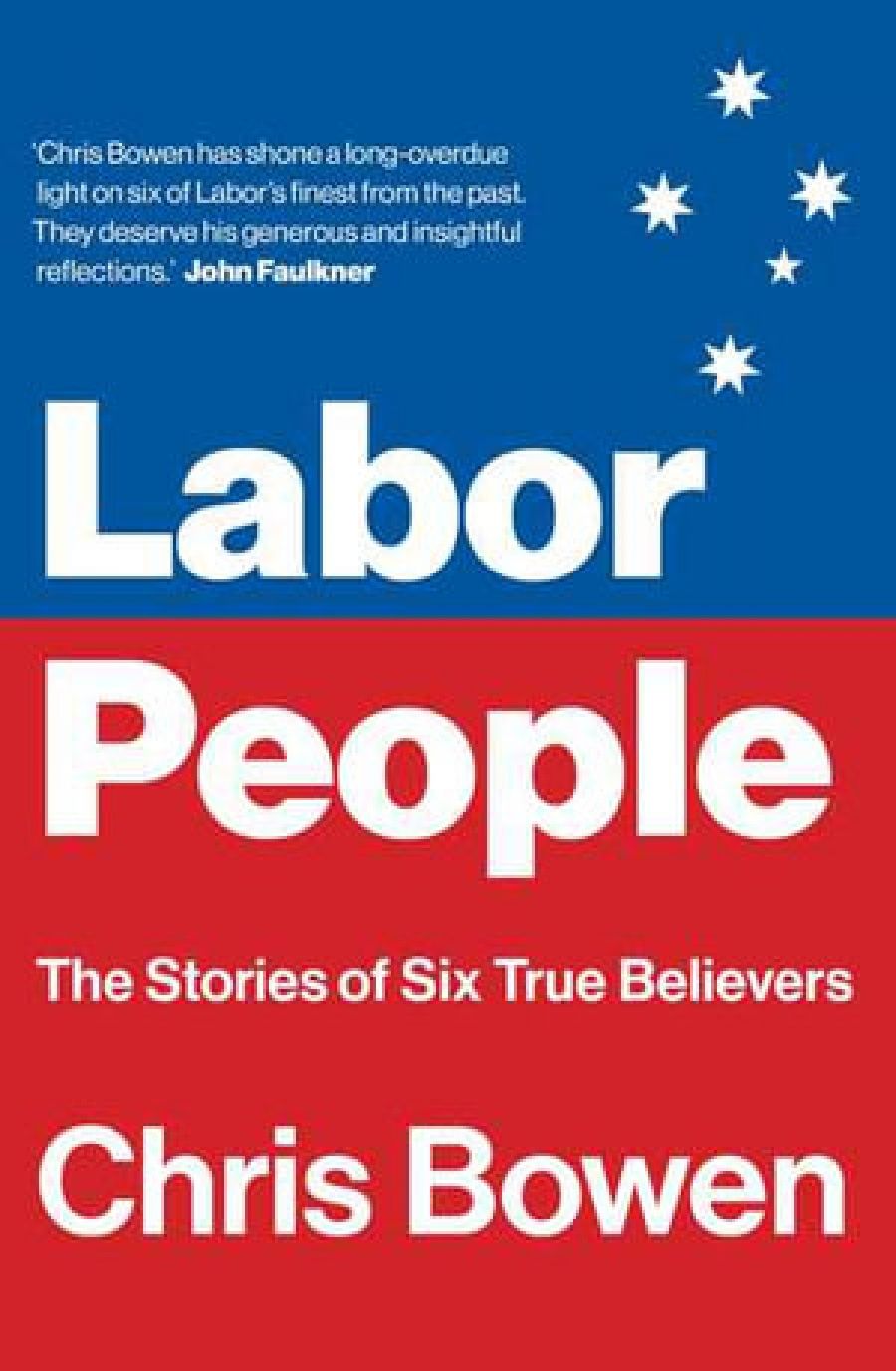
- Free Article: No
- Contents Category: Politics
- Review Article: Yes
- Article Title: True believers
- Article Subtitle: On six forgotten Labor figures
- Online Only: Yes
- Custom Highlight Text:
Contemporary Australian parliamentarians tend to be focused firmly on the present. Speechwriters may liberally sprinkle the speeches of politicians with references to a political party’s golden past, but an MP’s sincerest interest in history often emerges when he or she gets around to publishing a memoir of their time in office. A politician’s autobiography is an exercise that encourages selective, rather than frank, reflection on how history will portray them, their enemies and friends. Some politicians, thankfully, embrace a broader, less self-interested view of the importance of history. Labor Opposition frontbencher Chris Bowen is the latest serving politician to display a commendable fascination with historical research. His new book tells the stories of six relatively forgotten figures who made a strong contribution to the Australian Labor Party.
- Featured Image (400px * 250px):

- Alt Tag (Featured Image): Lyndon Megarrity reviews 'Labor People: The stories of six true believers' by Chris Bowen
- Book 1 Title: Labor People
- Book 1 Subtitle: The stories of six true believers
- Book 1 Biblio: Monash University Publishing, $29.95 pb, 255 pp
- Book 1 Readings Link: booktopia.kh4ffx.net/rnX7Gd
Given that the media, and indeed many historians, prioritise leadership and the personalities of prominent Labor leaders in their political discourse, Labor People: The story of six true believers provides a useful corrective. Bowen acknowledges the role of Labor men and women who helped hold the party together during difficult times or, alternatively, fought within the party for constructive change. The author provides balanced and entertaining profiles of such admirable Labor politicians as Ken Wriedt, a hard-working member of the Whitlam government who became a respected and reform-driven primary industry minister; John Dedman, who was a leading player in such postwar initiatives as the establishment of the Australian National University and the retraining scheme for former defence personnel; and Lilian Locke, a suffragist who worked within the ALP for a more significant political role for women.
Bowen’s profiles shed light on the personal cost of being involved in politics. Frank Tudor, for example, had the thankless task of leading the federal ALP during and after the damaging conscription debates of World War I, only to find his leadership under threat by rising star T.J. Ryan, the popular former premier of Queensland. Elsewhere, Bowen describes how Gertrude Melville, a member of the New South Wales Legislative Council, fought a very public battle against police brutality, which was ultimately not supported by her own parliamentary party. All six biographical subjects displayed a loyalty to their party that was not always rewarded or appreciated by colleagues.
The slightly informal tone of the prose suggests that the author wants to reach a wide readership. It is a pity, then, that the cover design is drab and that no photos or lively cartoons of Dedman, Tudor, Wriedt, or the other subjects of chapters are included. For the most part, Bowen’s writing style is accessible, although some of the biographical portraits are at times overshadowed by overlong descriptions of internal machinations within the ALP. While important for historical context, they become a drag on the narrative.
While some primary sources have been consulted, the book is heavily reliant on secondary sources. These are mostly used effectively, but there is an unfortunate tendency to accept uncritically the statements of historians and authors with strong links to the Labor party. For instance, Graham Freudenberg’s explanation of the rationale for selecting the inexperienced Wriedt for the primary industry portfolio in the Whitlam government rather than the more qualified candidate, Dr Rex Patterson (MHR Dawson), is restated by Bowen but not questioned: ‘Whitlam “believed that a minister in the House of Representatives in a marginal seat would be too vulnerable to industry lobbying and parochial pressures”.’
This was probably not the whole story. During the early 1970s, Patterson was a prominent Labor spokesman on agriculture, but his stress on protectionism and rural subsidies was becoming less popular within an increasingly urban-based federal ALP. By contrast, Wriedt no doubt seemed unlikely to challenge Whitlam’s new agricultural policies, such as the abolition of subsidies, and this presumably made him a ‘safe choice’ for the portfolio. As it happened, Wriedt believed in the prime minister’s reform agenda but sometimes questioned the pace of change.
The chapter on Wriedt is arguably the most compelling, largely because of the subject’s straight-talking personality and his long career as a key player in federal and Tasmanian politics, backed up by Wriedt’s own account in an oral history interview held at the National Library of Australia. Some of the other biographical studies, such as that of the ALP’s first federal deputy leader, Gregor McGregor, seem more prosaic; in spite of factional power struggles and the occasional go-it-alone and strong-willed leader, party politics tends to be a group process. McGregor may have contributed substantially to progressive party policy decisions and tactics, but it is hard to disentangle his contribution from that of other Labor figures in the 1890s and 1900s.
To Bowen’s credit, none of the six biographies is a hagiography. The author presents a warts-and-all portrayal of half a dozen men and women consumed by Labor politics and a desire to make a difference, providing solid historical context for the reader. Labor People is a worthy addition to the lengthy library of ALP histories and biographies. It will no doubt serve as a catalyst for future historians of the labour movement wishing to develop new insights beyond the leader myths that plague both major political parties in Australia.


Comments powered by CComment